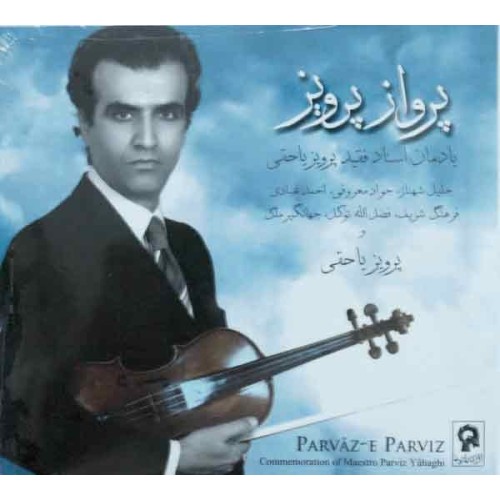- On sale!



Iran Persian Music 2 MP3 CD Album Parvaze Parviz
Playing:
Players: Parviz Yahaghi, Jalil Shahnaz, Javad Ma'roofi, Ahmad Ebadi, Farhang Sharif, Fazlollah Tavakol & Jahangir Malek
The santur (also santūr, santour, santoor ) (Persian: سنتور) is a Persian hammered dulcimer It is a trapezoid-shaped box often made of walnut or different exotic woods. The Persian classical santur has 72 strings. The name santur was first referenced in ancient Persian poetry. To date there has never been verifiable evidence what this name actually means, it is just a name and the only meaning it has in the Persian language is this instrument. The oval-shaped Mezrabs (mallets) are feather-weight and are held between the thumb, index and middle fingers. A typical Persian santur has two sets of bridges, providing a range of approximately three octaves. The right-hand strings are made of brass or copper, while the left-hand strings are made of steel. Two rows of 9 articles called "kharak" (total of 18 kharaks) divide the santur into three positions. Over each bridge crosses four strings spanning horizontally across the right and left side of the instrument. There are three sections of nine pitches: each for the bass, middle and higher octave called Poshte Kharak (behind the left bridges) comprising 27 notes all together. The top "F" note is repeated 2 times, creating a total of 25 separate tones in the Santur. The Persian santur is primarily tuned to a variety of different diatonic scales utilizing 1/4 tones (semi-tones) which are designated into 12 Dastgah's (modes) of Persian classical music. These 12 Dastgah's are the repertory of Persian classical music known as the Radif.
++++++++++
The tār
(Persian: تار) is a long-necked, waisted Iranian instrument. It has been adopted
by other cultures and countries like Azerbaijan, Armenia, Georgia, and other
areas near the Caucasus region. The word tar ( تار') itself means "string" in
Persian, though it might have the same meaning in languages influenced by
Persian or any other branches of Iranian languages like Kurdish. Therefore, Tar
is common amongst all the Iranian people as well as the territories that are
named as Iranian Cultural Continent by the Encyclopædia Iranica.
This is claimed to be the root of the names of the Iranian setar and the guitar
as well as less widespread instruments such as the dutar and the Indian sitar.
The exact place of origin of the tar cannot be confirmed. However, the tar was
invented in the territories of, or influenced by, the Iranian Empire:
Media/Persia (Iran), Afghanistan, and parts of the former Soviet republics, such
as Armenia and Georgia.
Tar is one of the most important Persian musical instruments. The formation,
compilation, edition, and inheritance of the most authentic and most
comprehensive versions of radif are all worked on tar. The general trends of
Persian classical music have been deeply influenced by tar players.
++++++++++
Setar (Persian: سه تار, from seh, meaning "three" and tār, meaning "string") is a Persian musical instrument. It is a member of the lute family. Two and a half centuries ago, a fourth string was added to the setar, which has 25 - 27 moveable frets. It originated in Persia before the spread of Islam.
++++++++++
The tonbak (also tombak, donbak, dombak; in Persian: تمبک, or تُمبَک ,تنبک ,دمبک ,دنبک) or zarb (ضَرب or ضرب) is a goblet drum from Persia (ancient Iran). It is considered the principal percussion instrument of Persian music. The tonbak is normally positioned diagonally across the torso while the player uses one or more fingers and/or the palm(s) of the hand(s) on the drumhead, often (for a ringing timbre) near the drumhead's edge. Sometimes tonbak players wear metal finger rings for an extra-percussive "click" on the drum's shell. Tonbak virtuosi perform solos lasting ten minutes or more.